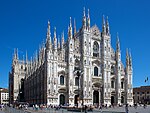Milan Cathedral

Milan Cathedral (Italian: Duomo di Milano [ˈdwɔːmo di miˈlaːno]; Lombard: Domm de Milan [ˈdɔm de miˈlãː]), or Metropolitan Cathedral-Basilica of the Nativity of Saint Mary (Italian: Basilica cattedrale metropolitana di Santa Maria Nascente), is the cathedral church of Milan, Lombardy, Italy. Dedicated to the Nativity of St Mary (Santa Maria Nascente), it is the seat of the Archbishop of Milan, currently Archbishop Mario Delpini. The cathedral took nearly six centuries to complete: construction began in 1386, and the final details were completed in 1965. It is the largest church in the Italian Republic—the larger St. Peter's Basilica is in the State of Vatican City, a sovereign state—and possibly the second largest in Europe and the third largest in the world (its size and position remains a matter of debate).
Excerpt from the Wikipedia article Milan Cathedral (License: CC BY-SA 3.0, Authors, Images).Milan Cathedral
Piazza del Duomo, Milan Municipio 1
Geographical coordinates (GPS) Address Phone number Website External links Nearby Places Show on map
Geographical coordinates (GPS)
| Latitude | Longitude |
|---|---|
| N 45.464166666667 ° | E 9.1913888888889 ° |
Address
Duomo di Milano
Piazza del Duomo
20122 Milan, Municipio 1
Lombardy, Italy
Open on Google Maps










